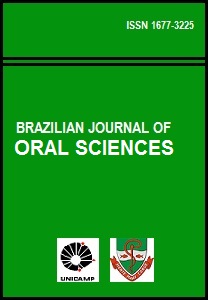Abstract
Aim: This study evaluated the influence of different chemomechanical caries removal techniques on the bond strength of an adhesive system to caries-affected and healthy dentin. Methods: Thirty healthy teeth were randomly divided into three groups: Group 1 (control): no caries removal technique was applied; Group 2: chemomechanical technique using Carisolv®; and Group 3: chemomechanical technique using Papacárie®. Twenty caries-affected teeth were divided into two groups: Group 4: chemomechanical technique using Carisolv; and Group 5: chemomechanical technique using Papacárie. The teeth received the application of an etch-andrinse adhesive system, were restored with composite resin, and then sectioned to obtain 4 hourglassshaped slabs from each specimen, which were subjected to a microtensile bond strength test. Data were analyzed statistically by ANOVA and Tukey’s test (a=0.05). Results: G1 (13.387 ± 6.1074), G2 (18.123 ± 3.2611) and G3 (12.781 ± 4.5652) presented statistically significant higher mean bond strength values than the other groups (p<0.05), but did not differ significantly from each other (p>0.05). G4 (6.228 ± 5.3435) and G5 (6.482 ± 3.2076) presented the lowest mean bond strength values and were statistically similar to each other (p>0.05). Conclusions: Neither of the chemomechanical caries removal methods interfered in the resin-dentin bond strength. However, lower tensile bond strength was found to caries-affected dentin.The Brazilian Journal of Oral Sciences uses the Creative Commons license (CC), thus preserving the integrity of the articles in an open access environment.
Downloads
Download data is not yet available.

